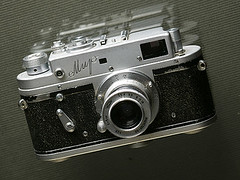Difference between revisions of "Mir"
(grammar, links) |
m (pic) |
||
| Line 1: | Line 1: | ||
| + | {{Flickr_image | ||
| + | |image_source= http://www.flickr.com/photos/siimvahur/2811531610/in/pool-camerapedia | ||
| + | |image= http://farm4.static.flickr.com/3048/2811531610_6b9a07898c_m.jpg | ||
| + | |image_align= left | ||
| + | |image_text= | ||
| + | }} | ||
The MIR is slightly simplified version of the well known FSU (former Soviet Union) [[Leica]] copy, the [[Zorki 4]]. Whereas the Zorki 4 was released for export from behind the iron curtain, the MIR was intended for internal consumption only. The only real difference between the Zorki 4 and the MIR is that the MIR is missing the Zorki's slow shutter speeds. Both the Zorki and MIR can be found for very little money. They are fully manual [[rangefinder camera|rangefinders]] that give you a nostalgic picture taking experience but you have to be a little careful when buying these old cameras to use. It might look vaguely like a Leica but the quality control and materials used in the Ukrainian factories did not really compare with their German counterparts. | The MIR is slightly simplified version of the well known FSU (former Soviet Union) [[Leica]] copy, the [[Zorki 4]]. Whereas the Zorki 4 was released for export from behind the iron curtain, the MIR was intended for internal consumption only. The only real difference between the Zorki 4 and the MIR is that the MIR is missing the Zorki's slow shutter speeds. Both the Zorki and MIR can be found for very little money. They are fully manual [[rangefinder camera|rangefinders]] that give you a nostalgic picture taking experience but you have to be a little careful when buying these old cameras to use. It might look vaguely like a Leica but the quality control and materials used in the Ukrainian factories did not really compare with their German counterparts. | ||
Revision as of 18:39, 30 August 2008

|
The MIR is slightly simplified version of the well known FSU (former Soviet Union) Leica copy, the Zorki 4. Whereas the Zorki 4 was released for export from behind the iron curtain, the MIR was intended for internal consumption only. The only real difference between the Zorki 4 and the MIR is that the MIR is missing the Zorki's slow shutter speeds. Both the Zorki and MIR can be found for very little money. They are fully manual rangefinders that give you a nostalgic picture taking experience but you have to be a little careful when buying these old cameras to use. It might look vaguely like a Leica but the quality control and materials used in the Ukrainian factories did not really compare with their German counterparts.
It should be noted that about 160,000 MIR's were made (between 1959 and 1961), but the Zorki 4 had over 1.7 million made during its (rather longer) production. It was offered with the I-22 Rigid 50mm f/3.5, the I-26 50mm f/2.8, or the Jupiter 8 50mm f/2. The Jupiter 3 50mm f/1.5 may have been an option, most likely with the Zorki 3 and 4 as an export option.
Many believe that the MIR shutter gear train is more reliable because it lacks the Slow Gear Train.
Because the viewfinder has a true +/- 1:1 magnification, it is 25% more accurate with faster lenses like the J-8 and J-3 and J-9 (85mm f/2). The FED 2, FED 6, and Zorki 6 all have a long base rangefinder similar to the pre-war Contax - about 90mm - which offer a similar accuracy but at a lesser viewfinder magnification than the 1:1 of the Zorki 3, 4 and MIR.
Links

|
- Zorki 4 Manual
- Another Zorki 4 Manual
- Russian Camera Collection (includes all Zorkis and the MIR)
- Zorki Rangefinder Cameras
- Rangefinder Cameras of the Soviet Era (includes beautifully restored and modifies examples)
- The Other Martin Taylor's review of the MIR
- Zorki 4, all models in Wayne Cornell's photography site
| Zorki cameras |
|---|
| FED-Zorki | 1 | S | 2 | 2-C (S) | 3 | 3M | 3S | 4 | 4K | Mir | 5 | 6 | 10/11 | 12 | 35M |